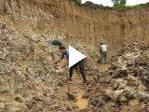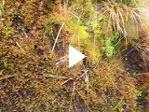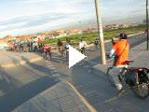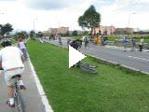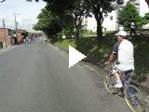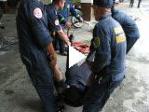Fearing that I was getting sick, I stayed two and a half days in Bucaramanga with a family that had found me on the internet. The mother is opening up a restaurant soon, and had to test the various dishes, for which I volunteered. If you make it to Bucaramanga, I highly recommend the restaurant Mimi Chocolate.
Feeling healthier, I followed the road out of Bucaramanga over the Andes, climbing to 10,000 feet and above the clouds. In the town of Berlin, at 10,500 feet, I became sick, and spent the next four days in bed, resting, and blowing my nose.
While in town, I met a number of police officers. Berlin, a town based on onion farming, has 800 residents, yet 60 police officers, all of whom carry hand grenades and M16 rifles. According to a few locals, the guerilla drove the police out of town 20 years ago, and town has been lawless since. The 60 police officers, who were sent about a month ago, seem to have fixed that problem. The road is the main road to Venezuela, and the police are also there to search cars for contraband and drugs.
When I entered Colombia, I wrote that president Uribe is incredibly popular because of the increase in security. Since then, I’ve talked to a number of people, notably middle class people in the cities, who oppose the president’s policies. They complain that all the investment goes into the army, and that funding for hospitals and education have been cut even as taxes have increased. ‘The root of the problem is poverty, and the army will not solve that.’ I am not sure what to believe, as although 60 police officers seems excessive, I can now travel in the country, and before president Uribe’s investment in the army and police, I am not sure I could have.
(Note on U.S. relations with Colombia: The government receives lots of aid from the United States, largely for the military. Uribe and president Bush share similar conservative values, and subsequently U.S. aid for Colombia has increased under the Bush Administration. This makes Bush popular for some people I talked to, while others complain that the U.S. orders Colombians what to do, and carry out very destructive campaigns to destroy cocoa crops, which are the source of cocaine. More here. )
Feeling better, I continued over the mountains to the city of Pamplona, which was celebrating its yearly independence festival. I stayed with a family and danced in the central plaza with the locals. Continuing on, I descended into my final city of Colombia, Cucuta, where I spent a day and was interviewed by three television stations before continuing on into Venezuela.





